1977 Austrian Grand Prix race report
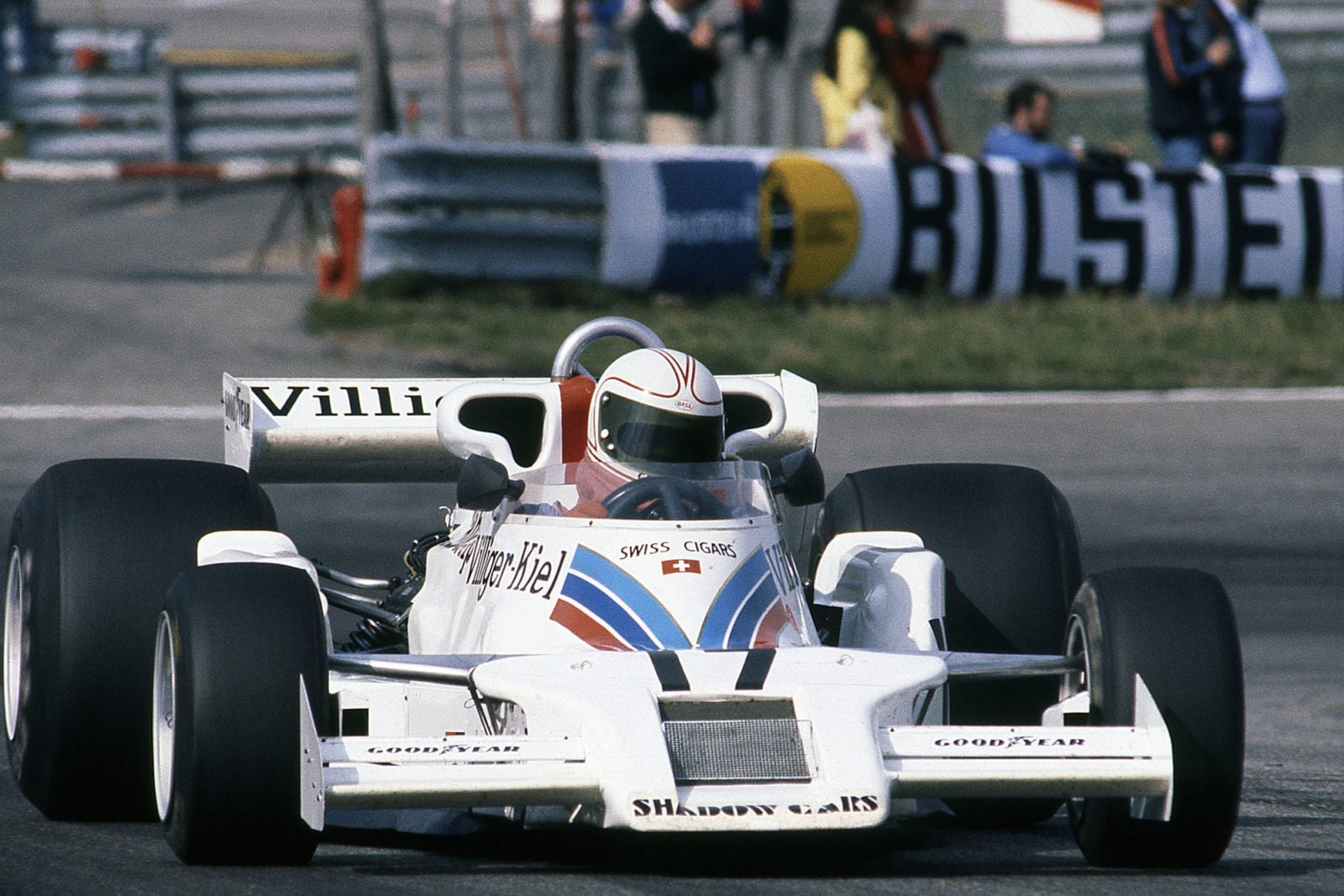
Alan Jones was a debut winner in his Shadow
Motorsport Images
A Well-Earned Victory – Knittelfeld, August 14th
In spite of the Osterreichring being in the middle of the country and difficult of access, from whichever direction you approach, few people miss the annual visit to the very scenic circuit. After the slow, twisty circuits like Monaco and Zolder the high-speed corners of the Osterreichring are refreshing, and after the stadium of Hockenheimring it redressed the sense of proportion of a lot of people, including some of the drivers. Following the lead set by the RAC/BRDC with the British GP over the question of too many entries for too few places, it was planned to have a qualifying day on the Thursday before official practice began in which the more worthy of the new-comers could stake a claim to join in the real thing on Friday. At the last moment the idea was dropped as BRM and a couple more withdrew, so that there was room for everyone on Friday.
There were no serious changes among the regular list of runners and surprisingly there were very few mechanical changes among the cars. The Shadow team was the most notable for change, as Patrese and his Italian backer has disappeared, leaving Tabatip cigars in full command of the advertising space on the cars, and Merzario was co-opted to take over DN8/5A. Alan Jones was driving DN8/4A with narrow fairing around the side radiators and a nose-mounted oil radiator, and his usual car DN8/3A arrived as a box of bits, and was built up into a complete car after the first practice day, but then only as a standby. The Ensign team changed their usual format, planning to use the newer car, MN07, for the race as it was spending too much time just standing about unused. Wolf were ringing the changes on WR1 and WR3, and Ferrari had 031 and 029 to race, with 030 as the spare car. Brabham had resurrected BT45/5B for Watson, in place of 6B and Ligier were planning to race their latest car JS7/03 which is slightly narrower and smaller than JS7/01, which they brought along as a stand-by. The German ATS team entered both of their Penske cars, with a Jarier in the later one and Hans Binder in the original one and a newcomer to the ranks (yet again!) was Ian Ashley with the Hesketh originally driven by Rebaque, now sponsored by Godfrey Bilton and his new Obex Oil company. Of the thirty entries, four were going to be disappointed as a maximum of 26 were permitted on the grid, of which the last six were going to be starting without any payment, according to the union rules of the Constructors’ Association, which is why everyone tries so hard during practice. It is one thing to qualify, but something more difficult to get paid for doing so.
In the interests of spectator appeal a slow second-gear ess-bend had been built at the top of the hill after the start. It used to be flat-out for everyone, last year the radius was changed to give more run-off space, and this year it was a sharp ess, and spectators were encouraged to use the banks overlooking this new layout, to watch the action of heavy braking, gear changing and the scrabbling from one lock to the other. A sort of circus stunt in the midst of a very high-speed, finely-balanced lap.
Qualifying
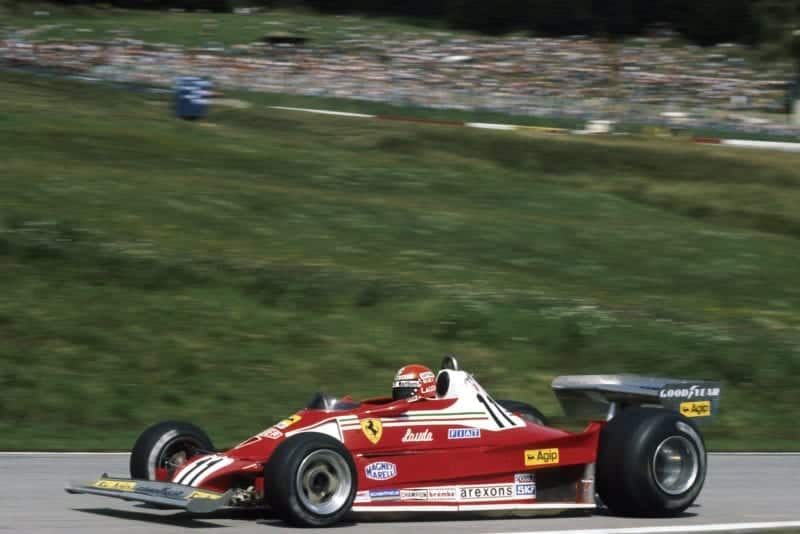
Niki Lauda put the Ferrari on pole at his home grand prix
Motorsport Images
Practice began on Friday morning, though many teams had been at the circuit the previous week, testing in readiness for practice. There had been a bit of a fracas between Colin Chapman and Goodyear over the hard, puncture-proof tyres the Wolverhampton firm insisted everyone used, for the Lotus 78 worked better on a softer rubber. Since the spate of tyre failures two three years ago, the top brass at Goodyear had insisted that tyres should be “bullet-proof”, which meant hard and resistant compared to what could be produced to achieve the ultimate in cornering power. Enzo Ferrari has been haranguing Good year all season about the apparent lack of development in racing tyres, but it now seems that there is a bit of a relaxing in the company policy. It was cool and dry during the morning 1½ hours of practice and with the introduction of the slow ess-bend lap times had in creased by five seconds or more, so that a time of 1 min 41 sec. looked quite good, while 1 min. 40 sec. was for the top runners. Hunt shattered everyone by doing 1 min. 39.69 sec., with apparent ease in the McLaren M26 and Lauda was hard behind him, but had to stop when a bearing in the throttle-linkage seized up. He took over the spare Ferrari and promptly put in a lap at 1 min. 39.99 sec., so that he and Hunt were in the “ace” class on their own.
In the afternoon Lauda was back in his proper car, the seized bearing having been replaced, and got down to 1 min. 39.32 sec., whereupon he stopped and stood on the pit wall and watched the others trying to approach his time. Stuck just scraped into the “ace” class, with 1 min 39.97 sec. in the Brabham-Alfa, but Hunt was the only one who looked like approaching Lauda’s time, repeatedly putting in sub-1 min. 40 sec. laps, but not close enough to worry the Ferrari driver. As practice ended Hunt had got down to 1 min. 39.54 sec. but that was as close as he could get. Andretti was very close to the “ace” class with 1 min. 40.04 sec. laps, but not close enough to worry the Ferrari driver. As practice ended Hunt had got down to 1 min. 39.54 sec. but that was as close as he could get. Andretti was very close to the “ace” class with 1 min. 40.04 sec., but it left Lauda, Hunt and Stuck as the top trio. Watson was almost a whole second slower than he should have been, not being able to get everything working in unison, and Scheckter was also well off the pace. Alan Jones was having engine trouble in the modified Shadow, and Regazzoni was nearly half-a-second slower than his new team-mate Tambay, who once again was impressing everyone with his smooth and effortless driving, recording 1 min. 40.29 sec., to give him seventh fastest overall. Keegan was looking very disconsolate as his Hesketh either did not handle properly or the engine misfired, and he was getting nowhere, and Jarier was having engine trouble. Binder, in the first of the ATS-Penske cars, had done well, much faster than Schuppan, who had replaced him in the Surtees team, and among the private-owners Lunger had done well, liking the high-speed corners.
During the night the whole area was rained on very heavily, so that car parks turned into autocross circuits and the thousands of campers had an awful time stemming the floods. For the Saturday morning untimed test-session there was still water coursing across the track on the top straight and Brambilla had an almighty accident, writing-off TS19/06 beyond repair, but stepping out unhurt and continuing in the spare Surtees until a water-pipe burst. Watson tried the spare Brabham and Scheckter was back in WR1, after changing to WR3 the previous afternoon. The circuit was still slippery in places and Peterson same in with the right-rear wheel of his Tyrrell all out of line, due to being hit up the back by Ribeiro, the March being badly bent. Jones tried the spare Shadow during the morning, but reverted to DN8/4A soon afterwards and Lafitte was trying both Ligier cars. On Friday Regazzoni had used Ensign MN06, but for Saturday he concentrated on the newer car, MN07.
In the final hour the sun shone and with the warmer conditions the general pace was quite a bit slower, so that Lauda’s best time of Friday looked safe for pole position. He could not approach 1 min 40 sec., but was not unduly worried and few others could either. Watson lost control of his Brabham at the ess-bend and dinged the nose against the bank, returning to the pits on foot to continue practice in the spare car, and Brambilla stopped practice when the left-front suspension collapsed on the spare Surtees. Laffite was in trouble with the ignition on the latest Ligier, so went out in the spare car, and Nilsson and Jones both had to abandon their regular cars and take the spare ones, due to engine trouble. With 15 minutes of practice left Hunt had a new set of tyres put on the McLaren M26 and went out for a determined last effort. He got down to 1 min 40.5 sec., then his pit gave him the signal “cool” and he cruised round in 1 min 59.8 sec., letting the tyres cool off, and then lap in 1 min. 40.4 sec., 1 min. 39.7 sec. and a last lap in 1 min. 39.45 sec. to make the best time of the day, but just missed the pole position. Meanwhile, Andretti was having a final fling and right at the end of practice got in a lap at 1 min 39.74 sec., to put himself in the “ace” class, along with Lauda, Hunt and Stuck, these four claiming the first two rows of the grid. The only familiar faces missing from the top end of the starting grid were those of Watson and Nilsson, the former in row six and the latter in row eight, their places being taken by Tambay in row four and Depailler in row five, back up at the sharp end again with the Tyrrell six-wheeler. Down at the back Schuppan and Villota just scraped on to the grid and Henton (March 761/7), Ashley (Hesketh 308E/3), Rebaque (Hesketh 308/2) and Ribeiro (March 761 B/3) were left out.
Race
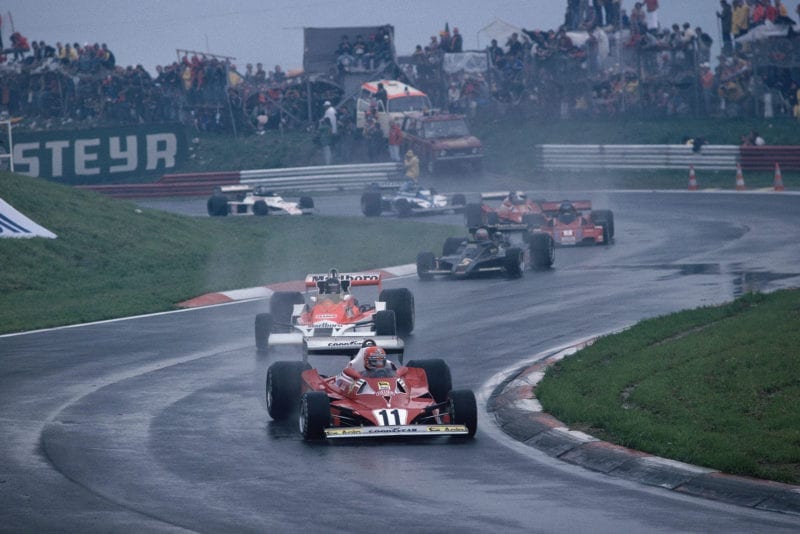
Lauda leads on a wet start
Motorsport Images
Sunday morning saw the rain pouring down, camping was sheer misery, the car parks had turned from autocross fun to trials quagmires, and a vast proportion of the crows had abandoned their cars anything up to three or four miles away and were splashing through the rain on foot to get to the slippery grass slopes all round the circuit. The final warm-up session was postponed for more than an hour until the rain eased of, after the supporting Super-vee race had been abandoned and re-scheduled for the end of the day. As there was a national holiday in Austria in the following day there were suggestions of postponing the whole thing for 24 hours, but the ramifications of such a drastic move discouraged the idea.
Around mid-day some of the contestants splashed around on the soaking surface, as the rain eased off, and then it was announced that come what may the race would start at the scheduled time of 2 p.m. In the Surtees team Brambilla took over Schuppan’s car, TS19/07, and the Australian driver used the spare car, TS19/02. Regazzoni was happy to use the newer of the two Ensigns, number MN07, and Scheckter settled for Wolf WRR3, Watson’s Brabham-Alfa BT45/5B was easily straightened out, Jones returned to Shadow DN8/4A and Nilsson to Lotus 78/2, while Laffite drove the new Ligier JS7/03. After the drivers had been taken round on a parade lap in a vast collection of Morgans, four cylinder and V8-cylinder models, gathered together by the Austrian Morgan Club, everyone got ready for a wet race. By the time the signal was given to leave the pits and drive round to the line-up grid in front to the grandstands the clouds were lifting and conditions were improving fast. Of the 26 starters, 25 set off on wet-weather tyres, the twenty-sixth being Hans Binder whose ATS-Penske was still being worked on with trouble in the fuel system. The grid positions were marked by girls in white holding large placards bearing the driver’s name on the side facing the cars as they came round the circuit. When the car was in position each girl turned her placard round so that the blank side faced the approaching cars, and also the time-keepers and officials, so that they could see at a glance who was missing from the grid. Eventually Binder roared away from the pits, but he was too late and had overstepped the time limit for coming under starter’s orders, so had to be penalised. When he returned he was waved into the pit lane and had to join the grid at the back, as the field set off on its pace lap. All this time the track had been drying rapidly, with improving weather conditions on the horizon. Everyone had a set of dry-slick tyres at the ready and as the starting time approached first one car was put onto dry tyres, then another, then nearly all of them, as it was obviously going to dry out, though the first few laps of the 54-lap race were going to be on a very damp surface. Team Lotus made a shrewd move by putting Andretti on “dry” tyres and leaving Nilsson on “wet” tyres he was going to get bogged down in mid-field, so it was worth a gamble. Shadow made the same ploy with Merzario, while Jarier and Schuppan also remained on “wet” tyres. Binder’s place on the grid was left vacant and the field went off on their pace lap. In orderly fashion they came down the hill to the starting line, a slight pause, and then with a roar in a cloud of spray they were off with Lauda just leading Hunt up the hill. However, Andretti had made a fine start and on the opening lap he shot past the McLaren and the Ferrari and pulled out an enormous lead as they came round the Jochen Rindt curve and down past the pits. Hunt, Lauda and Scheckter were following, then Tambay, Stuck and Nilsson, the Lotus already in seventh place from sixteenth on the grid. Only 24 cars went past, for Regazzoni had gone off onto the grass and slid helplessly almost out of sight down a slope, and Brambilla was out of his Surtees in the centre part of the circuit and trying to get it back on the track with the help of the marshals.
On the second lap Scheckter passed Lauda and took third place and while the Ferrari driver was worrying about the conditions and his tyres and the feel of the car, Nilsson shot past, having overtaken Stuck and Tambay. On lap 3 Nilsson was past Scheckter into third place and on lap 4 he went by Hunt and there he was, second with Andretti in the other Lotus a long way ahead. In a similar fashion Merzario made good use of his wet-weather tyres and climbed rapidly from fourteenth place up to sixth place, passing such notables as his team-mate Jones, Peterson, Teutemann, Mass and Lauda on his way. This unnatural state of affairs could not last for the track was drying rapidly and it was obvious the rain had gone for good, so that the knobbly wet-weather tyres would soon by overheating. Brambilla had rejoined the race and after two laps he stopped to have his seat-straps re-fixed, and Lafitte stopped after four laps as the Ligier was feeling decidedly odd. He carried on for a time until he discovered that the engine was blowing oil out onto his rear tyres. On the third lap Ian Scheckter had lost control of his March going up the hill to the new ess-bend, and amidst a whole bunch of cars he had a private accident, but there were some near-misses. For six glorious laps the Lotus team ran first and second, and then at the end of ten laps Nilsson could be seen heading for the pits and Hunt went by into second place. In very quick time the wheels were changed and Nilsson went off down the pit lane like a rocket, saving every possible second. He rejoined the race just in front of Keegan, who was leading the “rabbits” and was away up the hill on full song in thirteenth place, but well wound up to do something about it.
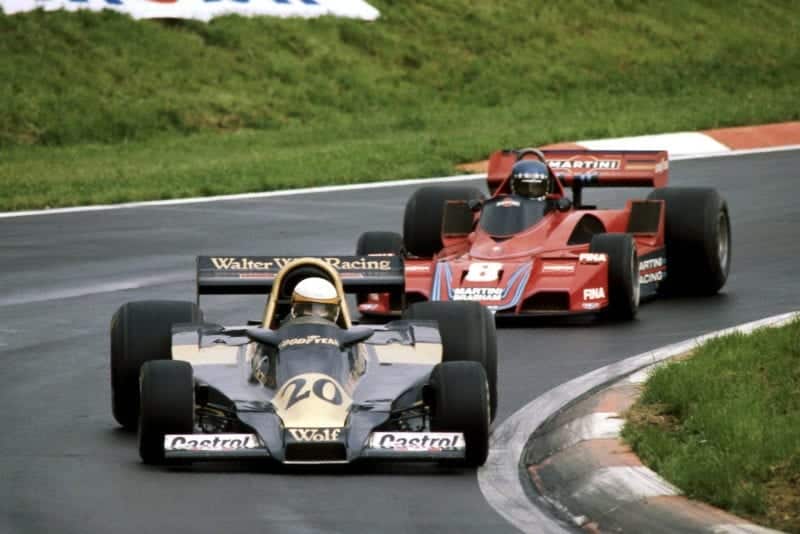
Jody Scheckter leads Hans Stuck
Motorsport Images
Lauda seemed to give up when Merzario went past him in the Shadow, and as he psyched himself into the impossibility of the situation and decided his tyres were all wrong, he slipped back to eighth and then tenth place, just in front of Reutemann who was not going very spiritedly. Merzario’s moment of glory faded on lap 11 when he had to stop and change tyres. Even worse was John Watson, who had given up completely and was running in twentieth place, amongst drivers like Neve, Lunger and Fittipaldi. He just couldn’t get into the swing of things and was feeling a bit unwell anyway. One driver who wasn’t giving up and was profiting from any weaknesses being shown by the accepted “stars” was Alan Jones. His Shadow was going well, feeling right, and as the track dried he picked off Mass Lauda and Tambay, moving up to fifth place just as Andretti’s Nicholson-McLaren Cosworth engine blew up in a big way on lap 12. This moved everybody up one, with Hunt now in the lead by a comfortable margin form Scheckter, Stuck and Jones who were nose to tail. Mass came into the pits as his engine had gone rough, but it was only a split exhaust manifold pipe, so he rejoined the race, down in fourteenth place. Whether it was the sight of Tambay in front of him we’ll never know but Lauda now got over his neurosis and began driving more like a works driver and re-passed the white Ensign. With Andretti’s retirement and Nilsson and Mass stopping at the pits, Lauda found himself in fifth place, but not a very meritorious one.
At 15 laps Hunt was leading Scheckter by 12 secconds, and Jones has passed Stuck and had his sights on the Wolf, which wasn’t being driven in a very inspired fashion. On the next lap he was by into a well deserved second place, the same 12 seconds behind hunt that Scheckter had been, indicating that Jones was driving consistently and Scheckter was dragging his feet. That 12-second gap remained constant, with no strain on Hunt or the McLaren M26, and though the Englishman eased of and did not use maximum r.p.m. he was steadily pulling away from the Australian. From 12 seconds the gap crept up to 14 seconds, 17 seconds and more, so that it looked as if Hunt had the race in his pocket. All eyes turned back to Nilsson when he caught and passed Peterson in one fell swoop and then latched on to Depailler. In two laps he was by and on the tail of Reutemann’s Ferrari, but not for long, though while pressing the Ferrari they both went by Tambay’s Ensign. Having dealt with Reutemann, the young Swede was now after Lauda’s Ferrari, but the Australian had woken up and was pressing to get past Stuck’s Alfa Romeo.
It was now lap 29 and as Nilsson came up behind the two 12-cylinder cars, Lauda was alongside Stuck as they went up the hill after the pits. As Lauda took the Alfa Romeo, Nilsson went as well and the two of them closed on Scheckter’s Wolf as though the couth African had given up. Nilsson’s driving was nothing short of inspired, and he started lap 32 right behind Luada, who was in turn right behind Scheckter. At the end of the lap Nilsson had gone by them both and was in third place. It was a memorable drive and made you wonder what all the others were doing, except for James hunt who was cruising around in first place in complete command of the race. As if to celebrate Nilsson’s climb up to third place the sun shone and everyone seemed happy. Hunt had 20 seconds lead over Jones, who was still driving hard, but Nilsson was teaching him slowly but surely, and just as people were calculating when the Lotus would catch the Shadow there was an almighty bang and Nilsson coasted past the pits with smoke, oil and bits of aluminium spraying out of the engine. The super development Cosworth V8 had blown up in the biggest possible way.
Now nobody was going to catch anybody, we were into lap 40 with only fourteen more to go and Hunt led by 22 seconds from Jones, Lauda, Scheckter, Stuck, Reutemann, Tambay and Peterson, the rest being a lap or more behind. Poor Watson had already been lapped by his team-mate Stuck, and was trailing along between Fittipaldi and Lunger feeling very sorry for himself. On lap 42 there was another bang as the Cosworth engine in Tambay’s Ensign blew up completely, and the young Frenchman lost a certain seventh place. Hardly had the smoke settled from that one than Hunt heard the death-rattle in his special development Cosworth engine, as a valve or two broke up, and he coasted to a stop on the forty-fourth lap with only ten to go and 23 seconds lead. For two or three laps there was an air of disbelief in the McLaren pit, but the joy in the Shadow pit was enormous as Alan Jones came by now leading the race, safely ahead of Luda and Scheckter. A lap behind the leader Keegan was heading the also-rans, but had Jochen Mass closing on him. On lap 46 Scheckter was coming up to lap Patrick Neve driving the Frank Williams March, when he made an error of judgement, got on the wrong line under braking and spun off into the soft ground on the edge of the track and stayed there, throwing away third place, which had not been in any danger. The young Belgian never even saw the Wolf. There was a lot of shouting and yelling after the race and some very unseemly behaviour by the head of the wolf-pack. Jones and Lauda had lapped the young Belgian without any difficulty, so now there were only five cars on the same lap.
With fingers crossed and praying for no more Cosworth explosions Alan Jones ticked off the remaining laps and though the partisan crowd urged Lauda on in the hope he would catch the Shadow, there was no hope and Alan Jones scored the first Grand Prix victory for the Shadow team and waved an arm to the sky as he took the chequered flag, while the team in the pits were smiling so broadly their faces were nearly splitting; even Alan Rees, the team manager, was allowing himself a smile, while some of the mechanics were improving on the original Cheshire Cat.
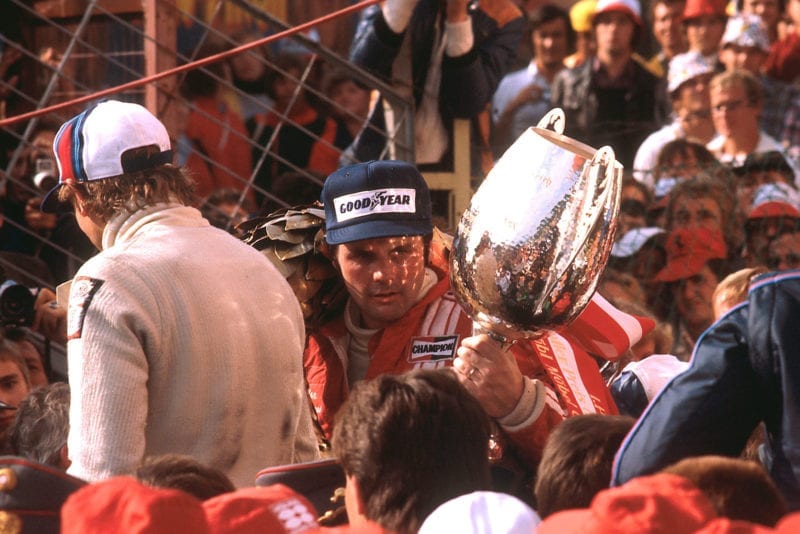
Jones capitalised on James Hunt’s misfortune to take the win
It was a well-deserved victory, for Jones had worked hard and well to get second place and Hunt’s bad luck was his good luck. Lauda finished in a second place that was little to be proud of and Stuck fought off a last minute challenge from Reutemann. An amazed Peterson actually finished a race in the six-wheeled Tyrrell and his team-mate also finished, but well down due to a stop to change a front tyre that deflated. In the closing stages Watson decided that being lapped by his team-mate was too much, and made an effort and re-passed Stuck, and on the final lap he caught and passed Neve, to take eighth place and at the same time he made the fastest lap of the race! – D.S.J.
Austrian Airs
Alan Jones is one of those drivers so like motor cars and enjoys driving racing cars, with no illusions about becoming a millionaire or a pop-star.
* * *
Eight Grand Prix races at the Osterreichring have had eight different winners, Ickx, Siffert, Fittipaldi, Peterson, Reutemann, Brambilla, Watson and Jones. All good racers at their time.
* * *
In supporting Formula Three race it was a day for the Irish; Derek Daly in a Chevron-Toyota won by six-tenths of a second from the Brazilian Nelson Piequet in a Ralt RT1.
* * *
Spectators had travelled by road to the Osterreichring from Switzerland, Germany, France, Yugoslavia, Czechoslovakia, Italy, Holland, Sweden and Great Britain.
